10 Basic Things to Know for Chinese New Year

January 27, 2020
Saturday, January 25, is officially the first day of the Lunar New Year, a beloved holiday that is nationally revered in China and other Asian countries. Businesses close, families gather to clean, cook, and feast together. Red lanterns and banners are hung up; acrobats, musicians, and dancers perform in parades. Dragons and lions dance in the street. Children get lucky red envelopes with money. Fireworks crackle and light up the sky. Over 20% of the world’s population celebrates this beloved holiday, including Chinese and other Asian diasporas. It’s a time to worship, eat with family, and prepare for a prosperous year to come.
Here are the basic details on 2020 Lunar New Year.
Chinese New Year is one of many names.
 Contrary to the popular moniker in America, Lunar New Year is celebrated in several Asian countries under different names and with different traditions. The Chinese call it chunjie, or Spring Festival, because it marks the end of winter’s coldest days and ushers in the beginning of spring. It’s also celebrated in Vietnam as Tet, Tibet as Losar, and in the Koreas as Solnal.
Contrary to the popular moniker in America, Lunar New Year is celebrated in several Asian countries under different names and with different traditions. The Chinese call it chunjie, or Spring Festival, because it marks the end of winter’s coldest days and ushers in the beginning of spring. It’s also celebrated in Vietnam as Tet, Tibet as Losar, and in the Koreas as Solnal.
The date changes every year.
 Lunar New Year’s start date depends on the lunar calendar, so unlike the Gregorian (solar) calendar, there’s no set date. It begins with the first new moon of the lunar calendar and concludes on the first new moon. This year, Lunar New Year begins on January 25th and ends on February 8th. The holiday lasts fifteen days.
Lunar New Year’s start date depends on the lunar calendar, so unlike the Gregorian (solar) calendar, there’s no set date. It begins with the first new moon of the lunar calendar and concludes on the first new moon. This year, Lunar New Year begins on January 25th and ends on February 8th. The holiday lasts fifteen days.
Clean the house and cut your hair beforehand.
 Preparations begin eight days in advance; this day is known as Little Year. People go to memorial and prayer ceremonies to honor the gods and ancestors, depending on their religion. Families clean their houses to sweep out the bad luck of the old year and pray to the Kitchen God, the most important domestic god who reports people’s behavior to the Jade Emperor a week before every New Year. Little Year is also the time to make stove candy, a sticky sweet that families offer to the Kitchen God to seal his lips and bribe him into giving the Jade Emperor a good report. His portrait, which watches over the household, is burned to send him to heaven and is replaced with a new one for the new year.
Preparations begin eight days in advance; this day is known as Little Year. People go to memorial and prayer ceremonies to honor the gods and ancestors, depending on their religion. Families clean their houses to sweep out the bad luck of the old year and pray to the Kitchen God, the most important domestic god who reports people’s behavior to the Jade Emperor a week before every New Year. Little Year is also the time to make stove candy, a sticky sweet that families offer to the Kitchen God to seal his lips and bribe him into giving the Jade Emperor a good report. His portrait, which watches over the household, is burned to send him to heaven and is replaced with a new one for the new year.
Since New Year is all about bringing good luck, certain things are forbidden. It’s taboo to cut one’s hair or clean the house during the fifteen days, so those things are done beforehand. Words with negative meanings, taking medicine, lending or borrowing, and breaking objects are also banned. People should not give each other mirrors as a gift, since it will reflect all their luck away.
Red Is Everywhere.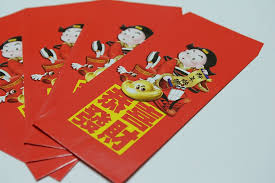
Red lanterns are hung outside doors to ward off bad luck. Red banners with lucky slogans are hung up. Red envelopes filled with money are everyone’s favorite gift. Red is the color of good fortune and joy, and it is everywhere for New Year.
What Are You Doing New Year’s Eve?
New Year’s Eve is when families come together for a giant reunion dinner. Children receive red envelopes with 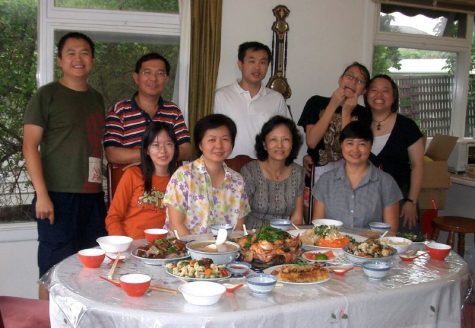 money. Religious ceremonies are held to say goodbye to the old year and make offerings to the ancestors, gods, and wandering souls (those who died without family). Everyone stays up late, believing that the longer one is awake, the longer their parents will live.
money. Religious ceremonies are held to say goodbye to the old year and make offerings to the ancestors, gods, and wandering souls (those who died without family). Everyone stays up late, believing that the longer one is awake, the longer their parents will live.
On New Year’s Day, at midnight, firecrackers are set off to start the day of greeting neighbors and friends. There aren’t specific guidelines for New Year’s Day, but most families spend their time burning false paper money for the ancestors, eating and drinking together, setting off fireworks, and attending parties or parades. Dragon and lion dancers, acrobats, and musicians get to show off in elaborate parades.
Food Is Fundamental
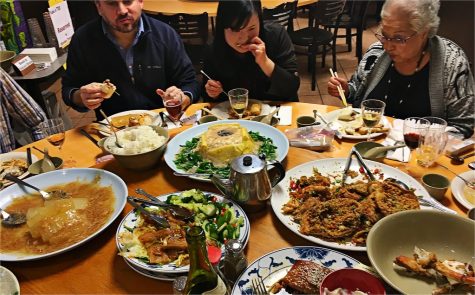
Feasting is a crucial part of New Year celebrations, and each sumptuous dish has a traditional symbolic meaning.
 Fish, usually steamed carp or catfish, is popular because the word for fish, 鱼 Yú /yoo, sounds like Chinese word for surplus. Fish is believed to bring prosperity. There are specific guidelines on how to serve and eat the fish. The whole fish must be on a platter, the head facing distinguished guests to show respect. No one may eat until the person who faces the head eats first. The fish shouldn’t be moved. The people facing the head and the tail should drink together for good fortune.
Fish, usually steamed carp or catfish, is popular because the word for fish, 鱼 Yú /yoo, sounds like Chinese word for surplus. Fish is believed to bring prosperity. There are specific guidelines on how to serve and eat the fish. The whole fish must be on a platter, the head facing distinguished guests to show respect. No one may eat until the person who faces the head eats first. The fish shouldn’t be moved. The people facing the head and the tail should drink together for good fortune.
Dumplings- minced meat or fish and vegetables wrapped and cooked  in dough- are one of the oldest, most popular New Year dishes, especially in Northern China. They represent wealth and are crafted to resemble silver ingots- ancient Chinese coins. The more dumplings you eat, the wealthier you are said to become in the new year.
in dough- are one of the oldest, most popular New Year dishes, especially in Northern China. They represent wealth and are crafted to resemble silver ingots- ancient Chinese coins. The more dumplings you eat, the wealthier you are said to become in the new year.
Spring rolls- Cantonese dim sum that consists of a vegetable/meat filling wrapped in a roll- get their name from the Spring Festival. Tangerines and oranges bring prosperity, as they are round and golden and their names sound similar to lucky sayings. Sticky rice balls’ round shape and sound symbolize family togetherness. Other special New Year treats include glutinous rice cake, turnip cake, and Peking duck.
 Chinese New Year’s most famous dish is longevity noodles. The stir fried noodles are extra long and kept intact so that the diners will be guaranteed a long life. They’re the last food to be eaten at the extravagant reunion feast, often served on a plate or in a bowl.
Chinese New Year’s most famous dish is longevity noodles. The stir fried noodles are extra long and kept intact so that the diners will be guaranteed a long life. They’re the last food to be eaten at the extravagant reunion feast, often served on a plate or in a bowl.
All of these customs are more like fun family traditions than superstitions and are followed in a lighthearted, jovial manner.
Happy Birthday!
Everyone becomes a year older. According to tradition, Chinese babies are one when they are born and count every New Year as a birthday. For example, I was born in April 2002, so I was one for 2002 and turned two when Lunar New Year 2003 arrived. Most Chinese people have two ages: their actual age, based on their birthday, and a nominal age based on this tradition.
Little Holidays Lead Up to Lanterns
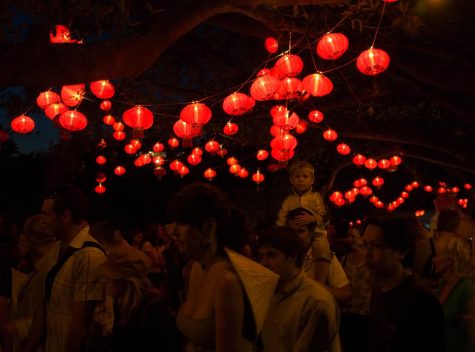
The next several days are special, albeit smaller occasions. There are days for good health, visiting in-laws, or ceremonies to commemorate significant animals like rats and horses in mythology and folklore. The Lunar New Year is also a popular time to get married. Gradually businesses start to reopen, and families prepare to part ways again.
On the last day of the Lunar New Year, everyone releases floating lanterns into the sky, share a final meal together, and admire the first full moon of the year. All decorations are taken down, and taboos are lifted.
Year of the Rat
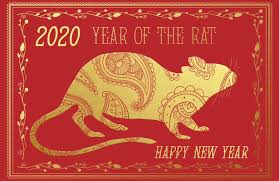
2020 is the year of the rat, the first animal in the Chinese zodiac. According to a popular myth, the Jade
Emperor, the chief deity, said the order of the twelve animals in the zodiac would be determined by a race. The rat tricked the ox into giving him and the cat a ride across the river; the rat pushed the cat into the river and jumped off the ox’s back to race ahead just as they reached the finish line, coming in first place.
Rats are seen as a sign of wealth, surplus, fertility, and cleverness. People born in the Year of the Rat are said to be cunning, energetic, likeable, and stingy with money. According to astrologers, they are most compatible with people born in the Year of the Ox, Dragon, and Monkey.
Fireworks
Fireworks have always been a New Year tradition. Before gunpowder was invented, peasants threw bamboo shoots into fire. At midnight on New Year, tons of fireworks are set off- the most the world ever sees. The tradition originates from the myth of the Nian monster, a predatory beast that used to haunt defenseless villages. The peasants scared the monster and other demons away with noise, fire, and the color red. Today, China produces 90% of the world’s fireworks and holds masterful fireworks shows to deter evil spirits and celebrate a new beginning.

May your New Year, wherever you’re from, be prosperous and auspicious.

